
views
Trapping the Cat

Identify a cat to tame. If you see a stray cat in your neighborhood that seems friendly and not averse to humans, you may be able to tame it. Taming a stray cat can be a difficult process that lasts several months. A feral cat may never behave the same way a domesticated house cat would, but many reach a point where they make loving pets and are able to live indoors. Some stray cats are actually lost cats that were previously domesticated. Providing food, shelter and attention is often the only thing required to tame a lost cat. Try leaving some food out for them and then petting them when they come close. If they allow it, there is a good chance they are a lost cat. Try to track down the owner before claiming the cat as your own. Look around town for any posters or fliers that might have been put up for this lost cat. Talk with your local human society and veterinarians to ask if anyone is looking for the cat you have found. It’s much easier to tame feral kittens than feral adult cats. Kittens have yet to learn the behaviors of either indoor or outdoor life. Adult cats are set in their old ways and habits and it can be tough to retrain an older cat. Socialize a feral kitten before it is eight weeks old. Socializing early on will help them grow comfortable with behaviors expected from an indoor cat. You should also let kittens stay with their mother until they are four weeks old. Newborn kittens will still have an umbilical cord stump on their stomach. They will also no open their eyes until seven to fourteen days have passed. If the kittens incisor teeth have grown in, it's likely about two weeks old. If you notice any teeth behind the canine and incisor teeth, where our molars are, the kitten is at least four weeks old. If the kitten has all of it's adult teeth, you can assume it to be around four months old. If a cat seems aggressive or hostile towards you, leave it alone.
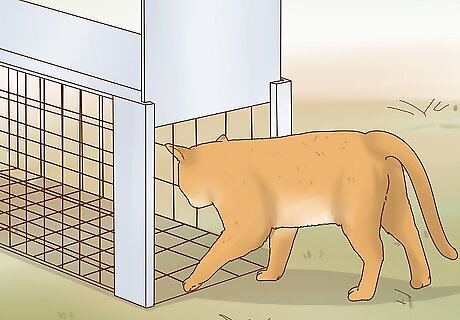
Trap the cat. You won't be able to simply pick up a feral cat with your hands. Feral cats are wild animals that must be handled with extreme care. The best way to start the process of taming a feral cat is to set out a trap. Feral cats may hiss, spit and scratch so let the trap take the abuse. Use a special trap designed for cats. Do not use traps designed for other animals. You can get traps from your local trap-neuter-release organization. Set the trap in a place where the cat spends most of its time. You'll need to bait it with a little tuna or other food to lure the cat inside.

Bring the cat to the vet for inspection. Place the trap on a blanket or towel in your car and drive it to the vet. Feral cats can carry diseases, and they usually have fleas and other ailments. Have the cat treated for these problems before you bring it home. Be careful not to handle it yet. The cat will not want to be touched. Seek medical attention immediately if you get scratched or bitten. Cat scratches and bites can lead to serious infections. Put a towel over the trap to help it feel more comfortable.
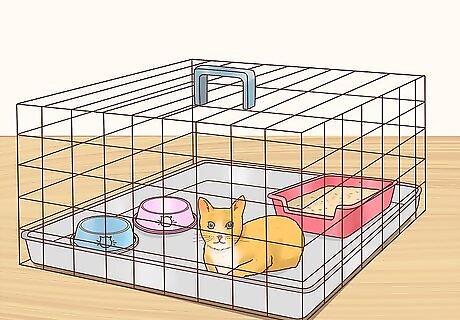
Transfer the cat to a prepared containment area. Don't do this until the vet has treated the cat and given the OK to take it home. The cat should spend its first few days in your house in a small, contained area to get used to its new setting. Use a carrier big enough for a litter box, bedding, and dishes for food and water. Keep the carrier in a room away from family members or other pets. Let the cat stay contained for two days before you touch it. Make sure it has enough food and water for two days. Put a full box of kitty litter in the cat's litter box. Make sure the cat won’t be able to escape as it may cause harm to the cat or your home. It is normal for the cat to be agitated during this time.
Socializing the Cat
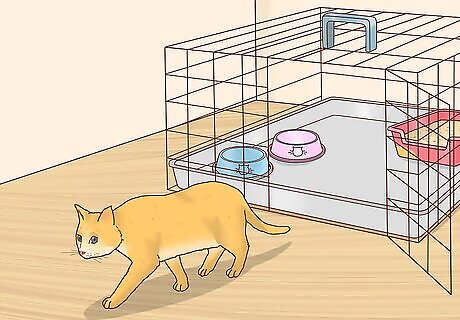
Gradually give the cat more room. Spend time near the carrier and speak in soothing tones until the cat seems calm when you're nearby. When the cat is used to your presence and no longer acting as wild, you can allow it more space to move around. Allow the cat to leave the carrier but stay in a small room that you have cat-proofed. Don't force the cat to come out, let it willingly come to you. Provide a private hiding space where the cat can go to reduce stress levels. Make sure it's an accessible spot so you can reach the cat if necessary. Make sure there's no way the cat can escape through a door, window or crack. Smaller rooms make the best socialization rooms. Alert your family members so that the cat won't escape the room if they enter.

Enter the room with a bag of treats. Plan to settle in for a few hours to help the cat get used to your presence. You can entice it to come closer by setting out a trail of treats leading to where you are sitting. Sit on the floor to get closer to the cat's level, and be patient while it gets used to you being there. Do this every day, possibly for weeks, until the cat comes close enough to be handled. Don't make eye contact with the cat, as they view it as a threat. Try lying on the floor to help the cat feel more comfortable, as you will appear smaller.

Consider luring the cat to you using the advantage of hunger. If the cat doesn't seem comfortable coming up to you even after several days, adjust how and when you feed the cat. Don't leave food out for the cat when you leave the room. Bring food in with you when you visit the cat and be with it while it eats. Keep the food dish close to you while you're feeding the cat. When the cat is finished eating and you're ready to leave the room, take the food with you. Don't starve the cat, make sure it is actually eating. You should leave water in the room at all times.
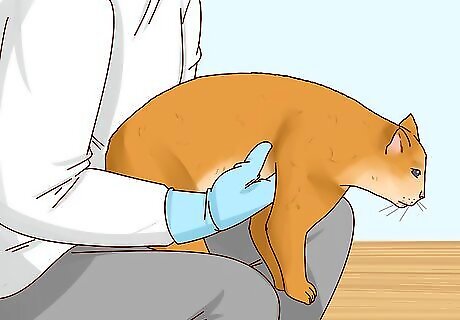
Approach the cat and pick it up. After several days, most cats will begin feeling more comfortable approaching you for food and treats. Now it's time to advance to helping the cat feel safe while being picked up or petted. When the cat comes close, use a towel to lift it into your arms. Lift the cat gently and carefully. If he cat runs away or hisses, try again tomorrow. Never use your bare hands to pick up a feral cat. You might want to go in wearing thick jeans, long sleeves and gloves. Don't scare the cat or force interaction. This will undo any trust. When holding the cat, try giving it some treats.
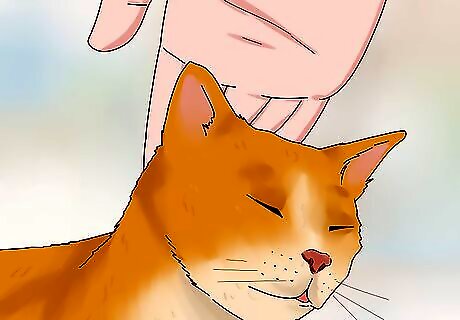
Pet the cat’s head from behind. When you successfully have the cat in your arms, pet the cat's head from behind, very gently. Speak to the cat in soothing tones. Stroke the cat's head and back for several minutes. If the cat resists, let it down. Do this every day until the cat comes to you to be picked up. Never approach from the front, as this will startle the cat. Always reward the cat for good behavior with some treats.
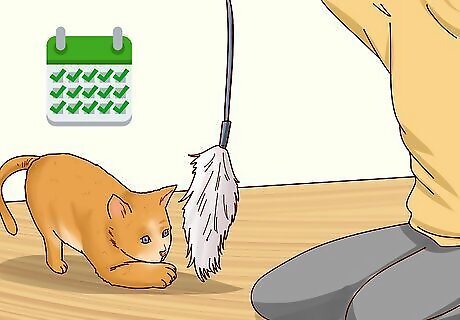
Play with the cat every day. The last part of the taming period can last more than a month. Keep working with the cat until it no longer exhibits fear or has any problem being handled and petted. Eventually the cat should feel comfortable being handled. Change the cats food and water daily. Pick the cat up, pet it, and talk to it at least once a day. The cat could remain skittish for quite a long time. Invite your friends to visit the cat to help it get used to people in general. The cat will eventually not require treats when you pick them up.

Keep the cat or place it up for adoption. Once the taming period is complete, the cat is ready for a normal domestic life. You may decide to keep the cat in your house or bring it to a shelter to put it up for adoption. If you keep the cat, be sure to get it neutered or spayed. Introduce the cat to other pets in your household slowly.
Using Trap-Neuter-Return
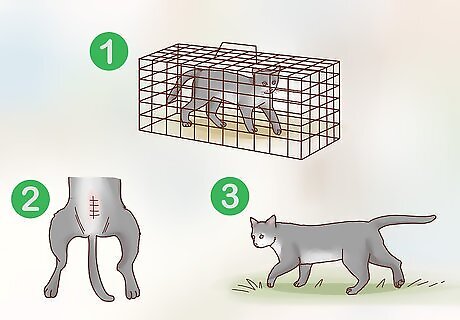
Learn about the Trap-Neuter-Return program. This program has been shown to be an effective way to keep wild cat populations down. The trap-neuter-return program is a non-leathal way to control feral cat populations. Populations left to grow unchecked can be bad for both cats and the neighborhood they live in. Cats that go through a trap-neuter-return program do not need to be house trained. These cats will go back to live outside, but they'll be much healthier if they're part of the program. See if there's already a program happening in your neighborhood. Talk with a local shelter or vet about resources available in your area.
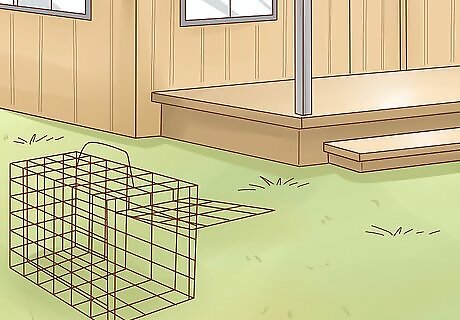
Set the trap in areas where you see feral cats. Use a special trap provided by your local trap-neuter-return program. Set the trap in the alley, backyard, or other place where you see a lot of cats hanging out. Trap cats and help them through the program one at a time. Do not try to trap a cat with a trap used for other types of animals, as it may injure the cat. Do not approach a stray cat and try to touch it with your bare hands. Seek medical attention immediately if you are bitten or scratched.
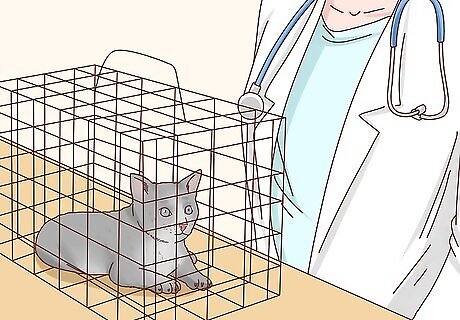
Bring the trapped cat to the vet. The vet will examine the cat for signs of disease, fleas and other maladies. Most importantly, the vet will spay or neuter the cat, so it won't be able to keep producing litters. After the cat has recovered, the vet will release the cat back into your care. Medical procedures and surgery should be free under the trap-neuter-return program. Some programs clip a cats ear, marking that they are in the program.
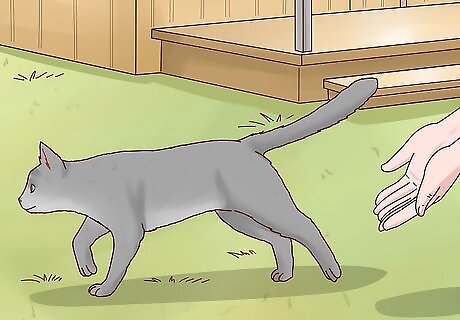
Return the cat to the neighborhood. Bring it back to the same spot where you trapped it, and release the cat back into the neighborhood. If you were feeding the cat before, continue to do so, and allow it to live out its life outdoors. Don't try to force any interaction with the cat.
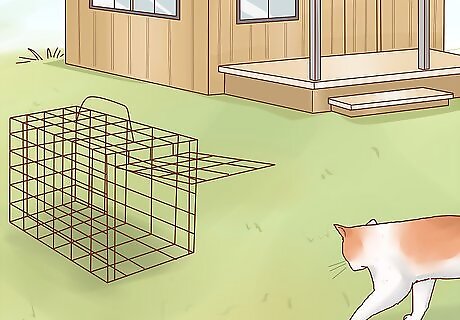
Repeat with other feral cats. Continue the process until the population has been reduced and the cats are all neutered or spayed. Without help, this could take many months to accomplish. Monitor the amount of feral cats in your neighborhood to check how successful your work is. Try to recruit neighbors to help with the program and increase results.



















Comments
0 comment